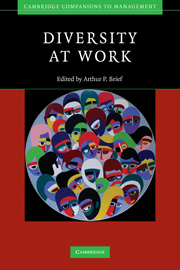Book contents
- Frontmatter
- Contents
- List of figures
- List of tables
- List of contributors
- Foreword
- Preface
- 1 Introduction: Where the sweet spot is: Studying diversity in organizations
- Part I Conceptual foundations
- Part II Emerging theoretical approaches
- Part III Moving ahead: Agendas for practice and research
- 8 Diversity initiative effectiveness: What organizations can (and cannot) expect from diversity recruitment, diversity training, and formal mentoring programs
- 9 was not that long ago: A story of gateways and pathways
- Index
- References
9 - was not that long ago: A story of gateways and pathways
Published online by Cambridge University Press: 19 May 2010
- Frontmatter
- Contents
- List of figures
- List of tables
- List of contributors
- Foreword
- Preface
- 1 Introduction: Where the sweet spot is: Studying diversity in organizations
- Part I Conceptual foundations
- Part II Emerging theoretical approaches
- Part III Moving ahead: Agendas for practice and research
- 8 Diversity initiative effectiveness: What organizations can (and cannot) expect from diversity recruitment, diversity training, and formal mentoring programs
- 9 was not that long ago: A story of gateways and pathways
- Index
- References
Summary
How long ago was 1964? A long time ago, some would say. The Beatles had just arrived in America, the World Trade Center design was underway, and Nelson Mandela was sentenced to his eventual 27-year imprisonment. The world of 1964 seems very distant from the world of today.
In that year, Title VII of the Civil Rights Act became law in the United States, outlawing discrimination in employment in any business on the basis of race, color, religion, sex, or national origin. Black or white, male or female, the gateway to opportunity opened.
Yet, stunning levels of segregation still exist in the workplace (Tomaskovic-Devey et al., 2006). In the United States, male–female and black–white segregation lessened between 1966 and 1980, but after 1980, only male–female segregation continued to significantly decline. Black–white segregation has essentially remained the same since 1980, and may have worsened in some sectors since 1995.
In fact, in order for sex-neutral employment distribution (i.e., true desegregation) to exist, more than half of all workers would have to switch jobs; for race-neutral (black–white) employment distribution to exist, more than half of all African-Americans would need to switch jobs (Tomaskovic-Devey et al., 2006). Both race and gender segregation remains significant, more than 30 years after the passage of the 1964 Civil Rights Act.
This puzzling state of affairs can be explained, we propose, by distinguishing between the gateway to opportunity and diversity in the workplace, and the pathway to success and effectiveness in the workplace.
- Type
- Chapter
- Information
- Diversity at Work , pp. 318 - 340Publisher: Cambridge University PressPrint publication year: 2008
References
- 5
- Cited by



